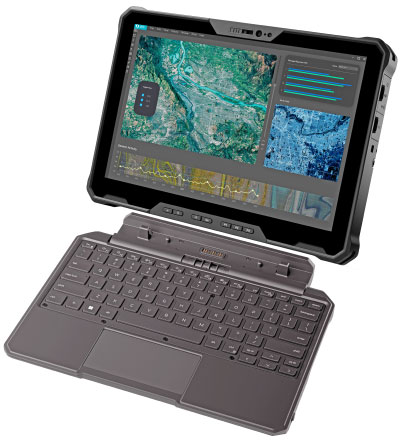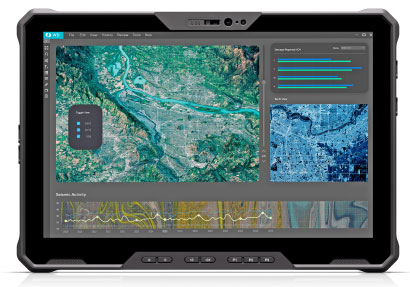|
Dell Latitude 7230 Rugged Extreme Tablet
Dell's fully-rugged tablet gets a major tech update
(by Conrad H. Blickenstorfer)
Share on:



On October 12, 2022, Dell introduced the Latitude 7230 Rugged Extreme Tablet, the fourth generation of the company's fully-rugged 12-inch tablet computer whose origins go back to June 2015. This latest version was launched almost exactly three years after its 7220 predecessor (see our full review), and it appears to bring a fairly major technology update to the platform. So what's new and what has changed?

First, there's speed. While Dell's consumer and business laptops are always meticulously kept up-to-date, the same doesn't go for the company's rugged tablets and laptops which often lag behind. To a degree that's understandable since purchase cycles are longer in traditional rugged computer markets such as law enforcement, government, military, industry and such.
Dell's competition, however, had moved on and so it was high time for Dell to upgrade the company's sole rugged tablet platform. And the new 7230 does just that, making a big jump from Intel 8th generation "Whiskey Lake" to Intel 12th generation "Alder Lake" Core processors (see our explanation of Alder Lake). Dell's launch info doesn't specify which processors will be available, just that it's i3, i5, and i7 versions.
This puts Dell in a good position because, other than Durabook's recently announced R11, none of the other Tier 1 vendors of fully rugged tablets have upgraded to 12th gen Alder Lake yet. That makes the Dell press release claim of having the most powerful 12-inch fully-rugged tablet plausible. Alder Lake brings an entirely different "hybrid" kind of processor architecture with power and economy cores, so we won't know about performance compares to the mostly 11th generation "Tiger Lake" rugged tablet competition until we run benchmarks.
Ancillary technology has been upgraded as well, with newer, more economical, and much faster LPDDR5 RAM, and twice the maximum RAM (32GB vs 16GB) available. Mass storage was already of the super-quick PCIe NVMe variety in the last generation of the tablet, so not much has changed there. Wi-Fi now is of the newest Wi-Fi 6E kind that's not only much quicker, but also provides access to a third band at 6GHz. Bluetooth is at the 5.2 or 5.3 level depending on whether customers opt for Intel or Qualcomm Wi-Fi. Mobile broadband remains at Qualcomm X20 (4G/LTE) or X55 (5G), each with either physical or eSIM. GNSS is via a uBlox NEO-M9N module, a minor upgrade over the NEO-M8 in the 7220.
Weight always matters in tablets, and here Dell claims that with a starting weight of just 2.78 pounds the 7230 is the lightest of all 12-inch fully rugged tablets. That may well be so, as Zebra's ET80 tablet weighs in at 2.80 pounds. It all matters on installed options.
The 7230 does have a new display, one that grew from 11.6 to 12.0 inches diagonally. Resolution went from the 16:9 1920 x 1080 to a 16:10 1920 x 1200, and at 1200 nits luminance the new screen is 200 nits brighter than the old one. Win-win on that front, though we're hoping to soon see higher resolution yet in these high-performance tablets (like the Zebra ET80/85's 2160 x 1440 or better).
The table below shows the major differences between Dell's new 7230 and the existing 7220 rugged tablets:
|
Dell Latitude
|
7230 Rugged Extreme
|
7220 Rugged Extreme
|
|
Launched
|
October 2022
|
October 2019
|
|
CPUs
|
Intel 12th gen Core
|
Intel 8th gen Core
|
|
Display
|
12.0-inch 1920 x 1200 pixel (189 ppi)
|
11.6-inch 1920 x 1080 pixel (190 ppi)
|
|
Display aspect ratio
|
16 : 10
|
16 : 9
|
|
Display luminance
|
1200 nits
|
1000 nits
|
|
Size
|
11.7 x 8.0 x 0.94 inches
|
12.3 x 8.0 x 0.96 inches
|
|
Weight
|
from 2.8 lbs.
|
from 2.9 lbs.
|
|
RAM
|
up to 32GB LPDDR5
|
up to 16GB LPDDR3
|
|
Mass storage
|
up to 2TB PCIe NVMe
|
up to 2TB PCIe NVMe
|
|
Wi-Fi
|
Wi-Fi 6E
|
Wi-Fi 802.11ac
|
|
Power
|
1 or 2 750 Wh/L
|
1 or 2 34Wh Li-Ion
|
|
Battery Life
|
Up to 20 hrs
|
Up to 19 hrs
|
|
Cameras
|
opt. 5 and 11mp
|
opt. 5 and 8mp
|
|
USB Type A
|
1 x USB 3.2
|
1 x USB 3.1
|
|
USB Type C
|
2 x Thunderbolt 4
|
1 x USB 3.0
|
|
Expansion
|
RJ45, HDMI, barcode scanner, serial, Fischer
|
pogo-pin modular
|
|
Handle
|
Opt. Soft or hard
|
Opt. Soft or hard
|
|
Kickstand
|
fixed angle
|
fixed angle
|
|
Sealing
|
IP65
|
IP65
|
|
Transit Drop
|
4-feet
|
4-feet
|
There's one thing that we should make clear. While the new 7230 at first sight looks almost exactly like the outgoing 7220 (or the one before it for that matter), that's really not the case. A detailed comparison of the tablet front and back and all sides shows that pretty much everything has changed. There seems more flush glass around the LCD and the housing bezel seems much thinner. The backside is different, as is each of the four sides. It's hard to say if this is an entirely new design or just a tweaked older one. Dell doesn't talk. Whether we learn a lot or nothing at all fully depends on who's in charge of Dell's much shuffled-around rugged group at the moment, and whether the expert tech press is in good graces or the page view counters are in charge.
Batteries: Watt hours per liter?
The size and capacity of the battery is always an issue in tablets. Unlike laptops which by their very design and concept are "part-time mobile," tablets are designed to be fully mobile. And so they must be as light and handy as possible, which big batteries aren't. Dell's 12-inch rugged tablet platform, while high-performance, has always had two small batteries and thus not much battery capacity. How much this time?
Well, hard to say, impossible actually, because the batteries are specced as "750 Wh/L" where normally you'd see voltage, amperage and then what truly matters, whr -- watt-hours. But the new Dell spec won't tell you that. Instead, it's Wh/L — watt hour per liter — which is a measure of battery density, not storage capacity. That's like advertising that a car uses 89 octane gasoline, but neither how big the tank is nor how many miles per gallon you can expect. As is, 750 Wh/L is quite good in terms of energy density for a mobile battery but, again, it skirts the issue of how much battery power you get in your new Dell tablet. Not good. The press release does claim up to 20 hours of battery life on Mobile Mark 14. But what's with all the befuddling terminology, Dell?
What has and hasn't changed
Dell prides itself in offering a rock-solid lineup of semi-rugged and fully rugged laptops and tablets with both the kind of long life cycle customary in vertical, governmental and industrial markets, and also generally providing backward compatibility with accessories, peripherals and docking solutions for desktops and vehicles. Whether that's true this time we're not sure; while the new tablet looks very much like the predecessor version, the I/O port and interface arrangements along the sides of the tablets are different, as is the backside.

Still, the new Dell Latitude 7230 Rugged Extreme Tablet remains a very attractive proposition for those who a) want an exceptionally well designed and executed tablet for tough jobs, b) want a pure tablet, but one with a perfectly matched optional detachable keyboard, and c) prefer one-stop shopping with a world-leading provider of commercial PCs with large scale production experience and extensive support.
Good connectivity, now with dual Thunderbolt ports
Flexible connectivity is crucial in enterprise and field deployments, and it's an area where most consumer tablets are lacking. Addressing that is not an easy task given the large number of possible connectivity requirements that may include legacy I/O such as serial or older card formats, especially while still living within the physical constraints of a compact and lightweight tablet.
In light of that, and looking forward, Dell added dual Thunderbolt 4 ports to carry most of the general purpose connectivity weight on the new 7230. And there's also a USB 3.2 Type-A port for when you don't have a cable with a USB Type-C connector handy. Whatever else you might need comes as options in two expansion I/O areas. On the side you can opt for HDMI 2.0 or another USB Type-A port. In the back you may opt for RJ45, mini-serial, a 1D/2D barcode scanner or a waterproof Fischer screw-on port.
What does Thunderbolt 4 bring to the table? Thunderbolt started as a joint effort between Intel and Apple for a faster and more powerful data transfer interface. It then evolved to use the popular reversible USB Type-C connector, combining all the goodness of the PCIe and DisplayPort interfaces, and also supporting the super-fast USB 4 standard with upstream and downstream power delivery capability. So with Thunderbolt 4 you need just one USB 4 cable and a Thunderbolt 4 dock to connect all at once to keyboards, mice, external drives, two external 4k displays as well as charging the tablet itself (Dell offers 65 and 90 watt USB-C chargers for the 7230). It can get a bit confusing between TB4 and all those USB plugs and versions, but it's a good step forward. (See our explanation of Thunderbolt 4)
Full ruggedness
Ruggedness and durability are sore subjects with consumer tablets where almost universally style prevails over substance. Dell once pointed out that the 5-year total cost of ownership of a rugged solution is actually only half that of a consumer product.
That doesn't mean a rugged device has to be a tank, just that it must be logically designed and built to handle whatever conditions and eventualities will be encountered in the real world. For the new Dell tablet, like for its predecessors, that includes IP65 sealing, where the "6" means it's totally dustproof and the "5" means it's also protected against low pressure water jets from all directions. The device can operate within an extremely wide temperature range of -20° to 145° Fahrenheit (-29° to 63°Centigrade), which means practically anywhere.
Dell says the device is also independently tested according to MIL-STD-810H (kudos for using 810H and not the older 810G) procedures for transit drop, blowing rain, blowing dust and sand, vibration, functional shock, freeze/thaw cycles, and more.

For use in hazardous locations, C1D2 (Groups A, B, C, and D) certification is available. This is becoming more and more important, and often a prerequisite for deployment in industries such as oil, gas, and petrochemical manufacturing, and many others where ignitable gases or vapor may be present.
Security
For security, the Latitude 7230 Rugged Extreme Tablet offers FIPS 140-2 TPM 2.0 functionality and 140-2 Level 3 certification to store secured information. Some of the available processors support vPro, a set of Intel security and remote management technologies that offer multiple lines of built-in defenses, and there are also Dell's advanced security and data protection and encryption tools. There's a cable lock slot for physical security, available FIPS 201-certified smart card reader, contactless smart card reader, and fingerprint reader, and also NFC.
What Dell's new 7230 rugged tablet means
Compared to Dell's overall sales volume, the market for rugged tablets is small and the competition from manufacturers focused on just rugged gear fierce. However, Dell is Dell and that name carries weight. Dell also allows customers one-stop shopping for all of their computing needs. So despite the frequent reshuffling of the small Dell rugged group and often lagging a bit behind in technology, Dell is definitely a Tier 1 contender in rugged systems.

The new 7230 rugged tablet should be much more powerful than its 7220 predecessor (a four-generation jump in Intel processor tech will do that), the new and slightly larger screen should be well received, and the inclusion of Thunderbolt 4 offers much potential. The 7230 isn't a bold step forward, but it seems a well-conceived upgrade to an already good machine, and for now it has newer tech than the primary competition.
Add to that Dell's substantial corporate capabilities and services and the one-stop shopping appeal, and this nicely upgraded version of Dell's rugged tablet should be a strong contender. — Conrad H. Blickenstorfer, October 2022
|




